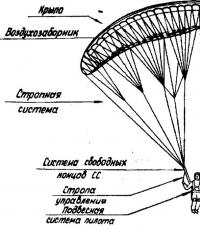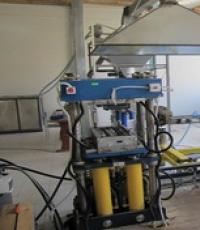Organic cotton fabric. What is this new fashion or how is organic cotton different from non-organic? What is this miracle cotton

Cotton is one of the most popular materials for making clothes. About 20 million tons of cotton are harvested annually in the world, which can cover about 40% of the world's demand for natural fibers. All the advantages of the materials are obvious: the fabrics are durable, wear-resistant, have strong heat-shielding characteristics due to the hollow structure of the fiber, and its porous structure guarantees good air exchange. In other words, the ideal material for a person. But not ideal for nature.

What is harmful to the production of conventional cotton
Excessive water intake
To produce ordinary cotton, a huge amount of water is required. According to the World Wildlife Fund WWF, the production of one kilogram of raw materials takes from 7,000 to 29,000 liters of water. Some experts believe that it was the exorbitant exploitation of land and water for growing cotton that was the main reason for the disappearance of the Aral Sea.
Use of harmful chemicals
During the production of cotton, a huge amount of various chemicals is released into the soil - pesticides, insecticides, chemical fertilizers, heavy metals, chemical dyes, bleaches and formaldehydes. Approximately 10% of all pesticides used in the world and about 25% of all insecticides are sown to cotton. The amount of pesticides and herbicides used is only growing every year, as the number of insects resistant to them is increasing. Wherein chemical substances in cotton fields - orthophosphates, trifluralin, toxaphene, methamidophos and many others - are highly toxic. The chemicals used in cotton processing pollute the soil, air and surface water.
genetically modified seeds
According to various sources, today 55% of the world's total cotton is grown using genetically modified seeds that are resistant to pests and herbicides. Plants created on the basis of such seeds contain Cry-toxins or Bt-toxins (species-specific protein toxins), which negatively affect some living organisms. Genetically modified crops are believed to reduce biodiversity.
Subsequent bleaching and dyeing
When processing standard cotton fiber, most industries use chlorine bleaches. As a result, toxic by-products are released into the environment. Also, in the case of dyeing fibers in conventional industries, technologies are used that have a damaging effect on the fibers themselves and the structure of the fabric, since the paints contain sulfur and heavy metals.

What is organic cotton and why is it better
The “100% Organic Cotton” label is increasingly seen on the products of many global brands: H&M, Walmart, C&A, Nike, Anvil, Coop Switzerland, Pottery Barn, Patagonia, and others.
For example, in early 2014, Stella McCartney, known for her love of organic cotton, cemented her position as an eco pioneer in the high fashion industry with the launch of the adidas by Stella McCartney line. To the collection for sports brand included models made from eco-friendly materials - organic cotton and yarn from recycled materials.
The European company C&A is one of the largest buyers of organic cotton. In 2013, she sold over 100 million garments made from this material. Products based on 100% organic cotton in the C&A collection are labeled "Bio Cotton".
In 2008, Levi's launched the "Levi's Eco" collection of eco-friendly jeans: the fabric for the models was made exclusively from organic cotton.
According to a 2009 study by the Organic Exchange Farm and Fiber Report, organic cotton production has increased by 20% since 2007. Organic cotton is grown in 22 countries of the world: Turkey, Syria, Tanzania, China, the USA, Uganda, Peru, Egypt and Burkina Faso are among the leaders in production. Truth, general production organic cotton in the world is still far from mass: only 0.76% of the total.

Organic cotton is grown on small farms in accordance with the principles of the so-called sustainable farming (sustainable farming). This means that toxic and persistent (non-degradable) synthetic pesticides, insecticides and fertilizers are not used in its cultivation.
In this way, soil and groundwater pollution can be prevented. So, only safe substances are used to repel insect pests, for example, garlic, chili peppers and soap, manual weeding is carried out to remove weeds, cotton is harvested by hand, and only organic fertilizers are used as fertilizers.
In order to prevent soil depletion due to one-sided use, crop rotation is used on organic cotton plantations whenever possible: in the first year, the fields are sown with cotton and peanuts (or chickpeas), in the second year with corn, vegetables and wheat.
This approach is called intercropping - a combination of different crops in one field. The corn crop helps restore soil fertility. After a while, it can be sown again with cotton, as enough nutrients will be accumulated in the ground.
Organic cotton is grown using conservative watering and irrigation methods such as drip irrigation. Thanks to "old" technologies, it is possible to save much more water than in conventional industries. In addition, water is supplied directly to the root of the plant - this significantly reduces its loss due to evaporation.
In addition, in the production of Organic Cotton it is impossible to use genetically modified cotton seeds, and the subsequent processing of the resulting yarn does not involve bleaching with chlorine: the fabric is dyed only with dyes based on natural ingredients.

How do you know if cotton is organic?
This is confirmed by certificates issued by independent commissions. These "insignia" guarantee that the material is produced without exposure to harmful chemicals and colored with safe dyes. Symbols about received certificates can usually be found on clothing labels.
The main transnational certification system for textile eco-products is GOTS (Global Organic Textile Standard). The GOTS quality mark confirms that the use of harmful chemicals has been limited or completely eliminated in the production, and the norms for using water have not exceeded the established maximum.
Other requirements include the use of environmentally friendly raw materials (“Organic” mark - at least 95% organic raw materials in clothes, the inscription “made with organic” - at least 70%), bleaching without chlorine, a ban on the use of formaldehyde and other hazardous substances.
Other notable certifications for organic clothing are the Oeko-Tex Standard 100 (tests samples for pH, formaldehyde, heavy metals, chlorine carriers, and protective agents like pentachlorophenol and tetrachlorophenol), fair trade Fair Trade, Organic Exchange.

Ekaterina Prosvirkina, Head of PR and Press at H&M Russia
H&M is closely involved in environmental issues and harm reduction from production textile industry, guided by the reduce principle. reuse. Recycle. Since 2010, the company has been heading annual rating Textile Exchange for the use of organic cotton - in 2010, 2011 and 2013 ranked first, in 2012 - second.
Over the past year, H&M has increased its use of organic cotton in its production by 29% compared to last year. All organic cotton used by H&M is independently certified.
One of the company's strategic goals is to switch to using exclusively organic cotton by 2020. Distinguishing organic cotton products is easy: all H&M clothing containing at least 50% certified organic cotton, marked with a special green Organic Cotton label.
Products with a green label in Russia can be found in all H&M concepts, from basic lines and children's clothing to the Trend fashion line.
More and more parents around the world are opting for organic baby products - clothing, baby food, hygiene products and toys. And this is not surprising, because every parent wants the best for his crumbs. For the delicate skin of the baby - only natural ingredients and components, for health - organic products, for complete comfort and happiness - only natural and environmentally friendly toys and clothes.
The first fabric that comes into contact with the thin skin of the baby should be gentle, soft, comfortable, safe, free of chemicals, dyes and fragrances, should not lose its shape or stretch. Are you saying this doesn't happen? It happens! This is organic cotton.
What is this miracle cotton?
Organic cotton is cotton that is grown without the use of any chemicals (pesticides, insecticides, chemical fertilizers), which means absolute safety. When growing and processing organic cotton, instead of mineral fertilizers organic materials are used, manual weeding is carried out to remove weeds, the soil is not treated with fertilizers and herbicides for at least three years, cotton is harvested by hand in the fields, and the manufacture of threads, yarn, fabric, as well as dyeing and production of ready-made clothes are carried out in accordance with the standards manufacturing organic products. In addition, in the production of Organic Cotton it is impossible to use genetically modified cotton seeds.
If you see the Organic Cotton quality certificate on the clothing label, this guarantees that the cotton yarn for the corresponding product was made in accordance with high environmental and social standards at all stages of production, namely:
- organic cotton has not been grown with genetically modified seeds
- no chemical fertilizers were used in the cultivation of cotton
- only safe substances were used to repel pests (for example, garlic, chili peppers and soap)
- ripened cotton was picked by hand
- no chlorine was used in the bleaching of the yarn
- when dyeing fabrics, dyes created on the basis of natural components were used
- people who grow organic cotton work in excellent conditions, have a decent salary and a fixed working day
Environmental damage in the production of conventional cotton
The production of ordinary cotton uses a huge variety of chemicals - pesticides, insecticides, chemical fertilizers, heavy metals, chemical dyes, bleaches and formaldehydes. It is absolutely certain that conventional cotton uses 16% more insecticides and pesticides than any other crop. In addition, all of these chemicals are highly toxic. Judge for yourself: orthophosphates, trifluralin, toxaphene, methamidophos, endosulfan, etc.
The chemicals used in cotton processing pollute the air and surface water.
In addition, part of the products of ordinary cotton processing enters the so-called human food chain. For example, cottonseed oil is used for food production and straw is often used for cattle feed. Thus, part of chemical fertilizers will inevitably get into food and then into the human body.
And the residual chemicals that are inevitably present in ordinary cotton underwear can cause at least irritation of the skin.
Fresh air and clean water are ours best friends…
…and clean food and clothing. This is especially true for our children. After all, the health of the future of mankind directly depends on us, on the health of our children.
Newborn babies have such sensitive, thin and delicate skin that any chemicals and toxins can easily penetrate through it. As parents, we are obliged to think now what our baby wears from birth, what can affect his health, what he breathes and what he drinks. When you go to the store, be sure to read the labels on baby products. We assure you, you will be very surprised!
Choosing organic products and natural fabrics is the best thing you can do today for the health of your future grandchildren.
Organic Cotton
The popularity of organic cotton products is gradually growing along with the growing popularity of a healthy lifestyle. And the label "100% Organic Cotton" can already be seen on the products of many of the world's leading brands: H&M, Zara, Walmart, C&A, Nike, Anvil, Coop Switzerland, Pottery Barn, Greensource and Hess Natur ...
According to the Organic Exchange Farm and Fiber Report 2009, organic cotton production has increased by 20% since 2007. True, the total production of organic cotton in the world is only 0.76%.
Today, organic cotton is grown in 22 countries around the world. The leaders in production (in descending order of rank) are: Turkey, Syria, Tanzania, China, United States of America, Uganda, Peru, Egypt and Burkina Faso.
Since at the moment a very small amount of organic cotton yarn is produced in the world, it is easy to guess that the production of things from it is much more expensive than from ordinary cotton, and this, of course, is its undoubted minus.
But by buying natural food and clothes, we are taking a step, albeit a small one, but still, to preserve the environment and the health of our children and future generations.
| organic cotton | Plain cotton | |
| Seed preparation | No genetically modified seeds or chemicals used | Treatment with fungicides and insecticides. Possible GMO Seeds |
| Soil preparation | Healthy soil. Crop rotation. | Use of synthetic fertilizers. |
| Weed control | Healthy soil creates a natural balance. Beneficial insects and agricultural crops in the fields. Manual weeding. | Aerial spraying of insecticides and pesticides. |
| Harvesting | By hand, without the use of chemicals. Falling leaves naturally | Use of toxic chemicals for leaf fall |
| Whitening | Use of safe bleaches |
Use of chlorine Bleaching releases toxic by-products into the environment |
| Fabric dyeing |
Use of natural dyes with low metal and sulfur content Weak effect on fabric fibers |
Damage effect on fibers and tissue structure. Paints containing heavy metals and sulphur. |
Today, the first products made from organic cotton have begun to appear on the Ukrainian market. These are products of well-known world manufacturers of children's and adult underwear, toys, towels, bath products, bedding, bedspreads and blankets for the home, etc., for example, Ladybird, Naturapura, Kushies, Minimink, Teddykompaniet, Heimess, Eke Home, Pognae, Green Kids, Little Monkeys, Lodger and more. These are the leaders of the organic industry, having the highest reputation in the market, thanks to the highest quality goods.
One of the most popular fibers for textile production is cotton. But not all types are the same. So, organic cotton is different from in the usual way production, safe for the environment. Things from this material - organic cotton - are recommended for newborns, they are so high quality and environmentally friendly. How does the production of conventional cotton harm nature, how is organic fiber grown? The features of this fabric are detailed below.
How conventional cotton is produced
In short, the peculiarity of organic cotton is that it is produced absolutely without harm to the environment. Unlike organic cotton, conventional cotton is grown using a large number of insecticides and other chemicals. This plant is processed many times more than other agricultural crops. So, to grow the required volume of cotton fiber, the following treatments are required:
- pesticides - means for pest control;
- insecticides - to kill insects;
- herbicides - weed control.

All these "cides" cause irreparable damage to nature: they pollute the soil, air and groundwater. 10% of all pesticides and 25% of insecticides used in the global textile industry come from cotton plantations. Producers force the land to work “for wear and tear”. In the last 80 years alone, cotton fiber has been received 30 times more, while the total area of cultivation has not changed. About 55% of the seeds are genetically modified, resistant to herbicides.
Pesticides are dangerous to humans. Fatal poisonings number in the thousands. Both animals and insects suffer from these substances. Mutations of some species are noted, and a more aggressive chemical poison is required for adapted living organisms. In addition to "cides", chemical fertilizers, dyes containing heavy metals, bleaches and other harmful substances are used in the production of cotton fabric.

Features of organic fiber
Cotton marked organic grown on farm plantations located in ecologically clean regions. The total amount of eco-cotton is just under 1% of the total production, but its share is constantly increasing. To stimulate growth, only organic fertilizers are used - manure and compost. Seeds are strictly natural. To repel pests, only natural natural remedies are taken: soap, garlic, pepper and other spices.
When growing bio-cotton, crop rotation is observed. If different crops grow on one piece of land, then the soil is regenerated in a natural way. In the production of ordinary cotton, the same site is constantly used, which leads to the depletion of humus, i.e. fertile layer. The consequence is an increase in chemical fertilizers.
Another difference with organic cotton is that it is harvested by hand. Cotton bolls ripen unevenly. The person determines which fibers can be harvested and which need to be given a little more time. Manual assembly guarantees the purity of the fiber, there will be no admixture of leaves and other parts of the plant. In comparison, chemicals are once again used to harvest ordinary cotton fibre. They contribute to the fall of the boxes, which simplifies the collection procedure.

In the production of eco-cotton, chlorine-containing bleaches, aggressive dyes with sulfur and heavy metals are not used.
Advice
When buying an organic product, pay attention to its color. Clothing made from organic fibers retains their natural color, of which there are only three: ivory, light green and light pink. Sometimes textiles are dyed, but only with natural dyes.Properties, care
The first thing to note is the hypoallergenicity of the material. That is why it is recommended for the smallest children and people with sensitive skin. The fabric has a porous structure that allows the skin to breathe. Other important characteristics eco cotton:
- strength;
- sweat resistance;
- wear resistance;
- gentle and soft, pleasant to the body.
The clothing label must include a certificate issued by an independent commission. The main certification is GOTS (Global Organic Textile Standard). labeled "organic" is made from 95% organic cotton, the label "made with organic" indicates 70% biofiber content.
Caring for organic cotton is similar to caring for delicate woolen garments. The main disadvantage of organic matter is, since it is not treated with chemicals for stability. Products are washed by hand or on a delicate mode at a temperature of 30-40 degrees. Spin - at minimum speed. After the first wash, an organic cotton product shrinks by 5%, so things are sewn with a small margin. Always follow the instructions on the label, and then the product will last as long as possible.
Buying organic cotton, you care not only about yourself, but also about the state of the environment. Even though buying one organic cotton item will cost much more, you will not worry about the health of the child, and you will also support the growing eco-product industry.
Indeed, everyone knows that cotton is a fiber of plant origin. Why is some cotton "organic" and some not?
Let's figure it out
The fact is that organic, or bio-cotton, is called such cotton, which was grown in special conditions, without harm to the environment. That is, it should rather be called "ecological cotton". What conditions allow cotton to be considered organic?
Organic cotton is grown without the use of insecticides and pesticides. It is known that up to 30% of the world use of insecticides and up to 11% of pesticides falls on cotton plantations. In the case of organic cotton, farmers use scent traps as insect protection.
It should also be grown without the use of chemical fertilizers, only natural raw materials should be used: humus, manure, and so on. Thus, the cultivation of organic cotton does not use toxic chemicals that accumulate in the soil, infect plants, as well as people who work on the plantation. They are also not contained in the final product - those fabrics that you use at home and wear, for example, on your children.

What are the reasons to choose eco-clothing and other products made from such cotton?
The first, and most obvious to a conscious person, is its environmental friendliness. By buying such cotton, you do not stimulate damage environment. The second reason that follows from this may be that you will protect yourself and your family from exposure to harmful chemicals.
Another reason is cost. Often, organic cotton products are cheaper, as farmers do not have to pay for chemical fertilizers, pesticides, insecticides, and so on.
Finally, many people who are prone to various allergic reactions claim that wearing organic cotton products is much more comfortable than using ordinary things.
How to choose organic cotton and not make a mistake?
First, of course, you can try to find specialized stores selling organic products in your city.
Secondly, on these products you need to look for the marking of one of independent organizations accredited by The International Organic Accreditation Service (IOAS) - European Organic, IFOAM Global Organic System and others (the full list can be found in the Accrediyation section on the IOAS website). Also, products can be marked with the mark of the International Organic Textile Standard (GOTS).
So, now you know what organic cotton is and why and how to choose it, which means that you have taken another step towards a healthier life in harmony with nature!
At the time when you are reading this article, cotton is being planted in some parts of the world, and a rich harvest is already being harvested in other areas. India, Egypt, California, Australia, Pakistan... The list of places is endless. It is known from official statistics that 20 million tons of cotton are harvested annually around the world.
Cotton is our favorite fiber, it is also the most versatile. It is an absorbent that absorbs moisture well, breathable, soft, durable, beautifully dyed, and a lot of fabrics are created from it. But cotton is not always good for people. And it does not always bring good to nature.
WHY IS THE PRODUCTION OF REGULAR COTTON HARMFUL?
1. Great amount required water. For 1 kg of grown cotton, 7,000 to 29,000 liters of water are required! The Aral Sea has not just dried up. It almost disappeared from the face of the earth as a result of the merciless use of water for irrigation of cotton.
2. Use of harmful chemicals, pesticides, insecticides, chemical fertilizers, heavy metals, chemical dyes, bleaches and formaldehydes. Approximately 10% of all pesticides used in the world and about 25% of all insecticides are sown to cotton. There is catastrophic pollution of soil and water.
3. More than 50% of cotton seeds are genetically modified.
4. The process of bleaching with the use of chlorine, the process of dyeing with dyes containing sulfur and heavy metals, the soaking of finished fabrics in formaldehyde - this is not a complete list of problems that are associated with cotton processing.
5. The labor of women and children is more often used in cotton production. And this, as you have already seen, is a harmful production.


WHAT IS ORGANIC COTTON AND WHY IS IT BETTER?
Organic cotton is good for everyone: our beautiful planet, people who work agriculture and cotton processing, as well as to us,those people who useI am the end product of this hard work.
GROWING. All stages of cultivation and production of organic cotton are strictly regulated by the international certificate GOTS (Global Organic Textile Standard). organic standardwhom farming requires
1. use only natural, organic fertilizers,
2. complete rejection of pesticides.
The result is fertile soil and clean water, a healthy environment for farmers and, as a result, healthier products for consumers.
Organic cotton is grown in 22 countries around the world in small farms: among the leaders of production are Turkey, Syria, Tanzania, China, USA, Uganda, Peru, Egypt and Burkina Faso. True, the total production of organic cotton in the world is still far from mass: only 0.76% of the total.
RECYCLING.The concept of "organic" is not only special conditions growing in the field. Once organic cotton is harvested, it is stored andprocessed separately from the rest of the wool. All stages of spinning, weaving, dyeing, finishing, cutting and sewing are carefully supervised to ensure that harmless substances are used in the process.
3. In the production of organic cotton, bleaching does notChlorine is used and only oxygen bleaches are used.
4. When dyeing, non-toxic dyes are used.
5. Formaldehyde is not applied. Did you know that in the textile industry, formaldehyde soaking is used to give smoothness to fabrics instead of expensive calendering and mercerizing processes.
6. Artificial water softeners are not used at all washing stages.
Maintaining a GOTS certificate has raised the barrequirements for the entire textile production, since organic products are slightly more expensive, and sometimes they are the same in cost as conventional ones, but they have pronounced competitive Benefits.






